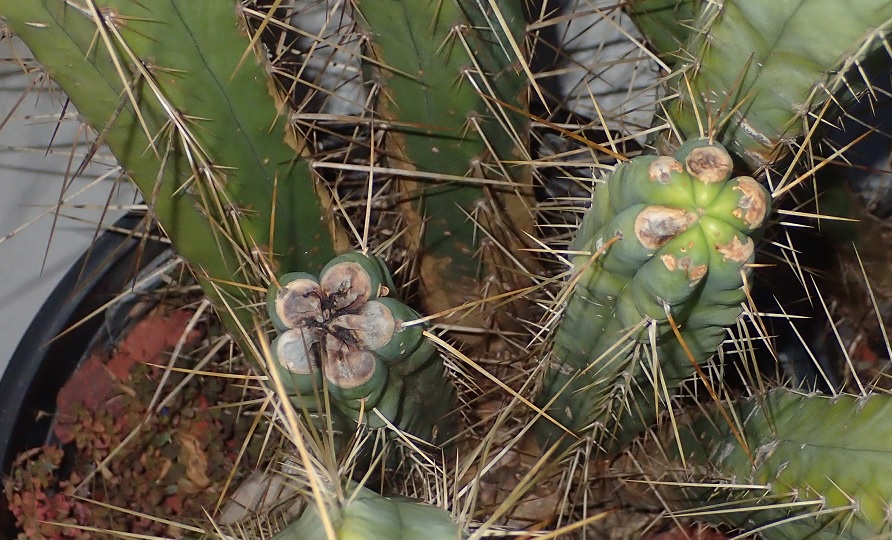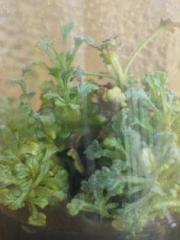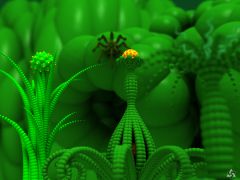Search the Community
Showing results for tags 'pests'.
-
Hi all - thanks for taking the time to look at this post. Hopefully you guys can help me find a solution for the issue I am having with a number of my ornamental plants. Essentially I think I have two types of problems going on with my cacti. 1# Scale bugs and #2 - Mites. Please see attached images. (Thousand words). #1 Scale #2 Mites?? (Patient Zero?) As you can see, it's a cactastrophy. I have left it for a few years, hoping that the problem would go away - but now it has shifted into the next gear and I'm worried that I might lose my entire collection. These plants have never been treated with any form of insecticide, and I hesitated to do that for obvious reasons, but now I'm prepared to pull out the big guns if need be, use systemics etc, and even cull / sell infected stock to any interested buyers. These guys have been a part of my life, and I feel like I have let them down. If possible I would really like to rescue this collection and keep the genetics for the long haul. Help please! Kind regards, tedzr
-
I have unbelievable amounts of fungal gnat larvae in my garden soil. Have had for years. But it's now getting in the way of me establishing outdoor Stropharia beds in my yard and I'm over it. Anyone have experience with predatory mites for knocking fungus gnat larvae on the head- specifically in garden soil ( not potted plant/ greenhouse ) environments? http://www.bioworksonline.com.au/index.php Other possibilities for dealing with the ongoing infestation have been rejected, but have included letting the neighbours chooks in the yard for two or three gnat breeding cycles, dernching the whole place in neem on a regular basis, and totally razing the surrounding vegetation so that the soil is more exposed and doesn't provide habitat Even more relevant would be tips and hacks from NNSW and surrounds
- 3 replies
-
- hypoaspis
- persimilis
-
(and 5 more)
Tagged with:
-
Recently I have been looking into biological pest controls. Most people are familiar with some of these such as lady bugs or predatory mites, however there is a wide range of pest control options from fungi, bacteria, predators or parasitoids. In my search I came across an amazing resource (http://www.biocontrol.entomology.cornell.edu/index.php). It is my plan to read several of these over the next couple of days and compile a list of which predator goes with each pest because the website doesn't seem to do that, and I feel that is a more appropriate way to organize the data. I would also eventually like to compile this into some kind of pdf, but that seems like a rather difficult and lengthy task at the moment. As I've said before, wholesale use of pesticides effects the good and bad organisms alike. I have started a similar topic regarding the use of plant compounds as an effective pest management strategy, Organic Garden Pests-Aside! Predators The arthropod predators of insects and mites include beetles, true bugs, lacewings, flies, midges, spiders, wasps, and predatory mites. Insect predators can be found throughout plants, including the parts below ground, as well as in nearby shrubs and trees. Some predators are specialized in their choice of prey, others are generalists. Some are extremely useful natural enemies of insect pests. Unfortunately, some prey on other beneficial insects as well as pests. Insect predators can be found in almost all agricultural and natural habitats. Each group may have a different life cycle and habits. Although the life history of some common predators is well studied, information on the biology and relative importance of many predatory species is lacking. In this document, we have included the more common and better understood beneficial predators. Major characteristics of arthropod predators: adults and immatures are often generalists rather than specialiststhey generally are larger than their preythey kill or consume many preymales, females, immatures, and adults may be predatorythey attack immature and adult prey Relative Effectiveness Most beneficial predators will consume many pest insects during their development, but some predators are more effective at controlling pests than others. Some species may play an important role in the suppression of some pests. Others may provide good late season control, but appear too late to suppress the early season pest population. Many beneficial species may have only a minor impact by themselves but contribute to overall pest mortality. Often too, the role of the beneficial predators has not been adequately studied. Surveys of agricultural systems give an indication of the potential number and diversity of predators in a crop. For example, over 600 species of predators in 45 families of insects and 23 families of spiders and mites have been recorded in Arkansas cotton. Eighteen species of predatory insects (not including spiders and mites) have been found in potatoes in the northeastern United States. There may be thousands of predators per acre, in addition to many parasitoids. Although the impact of any one species of natural enemy may be minor, the combined impact of predators, parasitoids, and insect pathogens can be considerable. Predators Table of Contents Pathogens and Antagonists of Plant Disease and Post-Harvest Decay Insects and mites, like plants, humans, and other animals, can be infected by disease-causing organisms such as bacteria, viruses, and fungi. Under some conditions, such as high humidity or high pest abundance, these naturally occurring organisms may multiply to cause disease outbreaks or epizootics that can decimate an insect population. Diseases can be important natural controls of some insect pests. Some pathogens have been mass produced and are available in commercial formulations for use in standard spray equipment. These products are frequently referred to as microbial insecticides, biorational, or bio-insecticides. Some of these microbial insecticides are still experimental, others have been available for many years. Formulations of the bacterium, Bacillus thuringiensis or Bt, for example, are widely used by gardeners and commercial growers. Most insect pathogens are relatively specific to certain groups of insects and certain life stages. The microbial products do not directly affect beneficial insects and none are toxic to wildlife or humans. Specificity, ironically, can be a disadvantage to the commercialization of these products because their small market may limit profitability. Unlike chemical insecticides, microbial insecticides can take longer to kill or debilitate the target pest. This may limit their use to crops that can sustain some insect damage. To be effective, most microbial insecticides must be applied to the correct life stage of the pest, and some understanding of the target pest's life cycle is required. Some microbial insecticides must be eaten by the insect to be effective. Good spray coverage is therefore important. Major characteristics of insect pathogens: they kill, reduce reproduction, slow growth, or shorten the life of peststhey usually are specific to target species or to specific life stagestheir effectiveness may depend on environmental conditions or host abundancethe degree of control by naturally occurring pathogens may be unpredictablethey are relatively slow acting; they may take several days or longer to provide adequate controlthey may cause epizooticsMicrobial insecticides are compatible with the use of predators and parasitoids, which may help to spread some pathogens through the pest population. Beneficial insects are not usually affected directly because of the specificity of a microbial product, but some parasitoids may be affected indirectly if parasitized hosts are killed. Insecticide applicators should note that although microbials are non-toxic to humans in the conventional sense, safety precautions should be followed to minimize exposure.Pathogens Table of Contents Antagonists Antagonists of plant disease and food spoilage microorganisms are not yet well understood. However, the research that has been done has yielded exciting and promising results, and the study of antagonists has become a rapidly expanding field in plant pathology. Worldwide, diseases of crop plants cause losses estimated to be 12%, and post harvest losses due to food spoilage have been estimated to be between 10% and 50%. In the United States, these figures are estimated to be 12% and 9%, respectively. Finding ways to prevent microorganisms from causing these losses would help ensure a stable food supply for the world's ever expanding population. Outside of agriculture, diseases can cause the destruction of entire stands of plants in marshes, forests, or other natural settings, and in other plant systems. Knowledge of the interactions among microorganisms and ways to manipulate microbiota is growing as research in this field rapidly expands. Antagonists have been successfully used to suppress tomato mosaic, foot and butt rot of conifers, citrus tristeza disease, and crown gall of several crops. Seeds have been coated with antagonists that reduce infection by pathogens and also enhance plant growth. Brown rot of peaches in storage was controlled under simulated commercial conditions by incorporating the antagonist Bacillus subtilis into wax used in the packing process. Inoculation of hosts with antagonists has been used with good results against a common fungal pathogen of conifers and chestnut blight. The future also holds much promise for the suppression of plant-parasitic nematodes by microbiota. Growers have applied antagonists to the above-ground parts of plants, to the soil (and roots), and to plant seeds. The above-ground environment is the least stable for antagonists because of the extreme variability in moisture and nutrients. Soil is a more stable environment for microbiota, but soil in most fields is generally nutrient poor, pH may range from 4-8, and temperatures and moisture may vary widely. In contrast, greenhouse planting mixes can be managed more effectively to promote antagonist colonization. Finally, it is practical to treat seeds to favor microbial antagonists. To be most effective, antagonists of plant disease and food spoilage should be: genetically stableeffective at low concentrationseasy to culture and amenable to growth on an inexpensive mediumeffective against a wide range of pathogens in a variety of systemsprepared in an easily distributable formnon-toxic to humansresistant to pesticidescompatible with other treatments (physical and chemical)non-pathogenic against the host plant Relative Effectiveness Under ideals conditions, such as in the laboratory, antagonists can completely protect plants from pathogens. In the field, disease control is likely to be less successful. Proper deployment of the antagonist appears to be crucial. Critical factors include moisture and nutrient availability and pH. If the deployment system can meet the needs of the antagonist, successful colonization is more likely. Careful selection of an aggressive strain of the antagonist is also important. Parasitoids Insect parasitoids have an immature life stage that develops on or within a single insect host, ultimately killing the host, hence the value of parasitoids as natural enemies. Adult parasitoids are free-living and may be predaceous. Parasitoids are often called parasites, but the term parasitoid is more technically correct. Most beneficial insect parasitoids are wasps or flies, although some rove beetles (see Predators) and other insects may have life stages that are parasitoids. Most insect parasitoids only attack a particular life stage of one or several related species. The immature parasitoid develops on or within a pest, feeding on body fluids and organs, eventually leaving the host to pupate or emerging as an adult. The life cycle of the pest and parasitoid can coincide, or that of the pest may be altered by the parasitoid to accommodate its development. The life cycle and reproductive habits of beneficial parasitoids can be complex. In some species, only one parasitoid will develop in or on each pest while, in others, hundreds of young larvae may develop within the pest host. Overwintering habits may also vary. Female parasitoids may also kill many pests by direct feeding on the pest eggs and immatures. Major characteristics of insect parasitoids: they are specialized in their choice of hostthey are smaller than hostonly the female searches for hostdifferent parasitoid species can attack different life stages of hosteggs or larvae are usually laid in, on, or near hostimmatures remain on or in host; adults are free-living, mobile, and may be predaceousimmatures almost always kill host Relative Effectiveness Whereas insect predators immediately kill or disable their prey, pests attacked by parasitoids die more slowly. Some hosts are paralyzed, while others may continue to feed or even lay eggs before succumbing to the attack. Parasitoids, however, often complete their life cycle much more quickly and increase their numbers much faster than many predators. Parasitoids can be the dominant and most effective natural enemies of some pest insects, but their presence may not be obvious. It is often necessary, to determine the extent of parasitism, to dissect or rear samples of pest insects to see if any adult parasitoids emerge. Parasitoids can be parasitized by other parasitoids. This phenomenon, known as hyperparasitism, is a natural occurrence, can be common, and may reduce the effectiveness of some beneficial species. Little can be done to manage hyperparasitism. Pesticide Susceptibility Parasitoids are often more susceptible to chemical insecticides than predators. Adult parasitoids are usually more susceptible than their hosts. Immature parasitoids, especially if protected within the egg of their host or in their own cocoon, may tolerate pesticides better than adults, but immature parasitoids will usually die if their host is killed. Parasitoids Table of Contents
- 21 replies
-
- 5
-

-
Howdy Folks. I have done a thorough forum search and could not find anything regarding the circumstances i will be faced with, so i have decided to ask you lot for any advice or legal know how when it comes to moving plants across state boarders by car. In late January 2014 i will be moving from Perth W.A to Mullumbimby in Northern New South Wales, This will be the biggest move of my life so i hope it all goes to plan. I will be driving with a friend through the Nullabor Desert, crossing into South Australia and then from south Australia into New South Wales. I will be taking my friends and my own possessions along on the journey, this includes my cacti collection and various other plants ( Banisteriopsis Caapi, Psychotria ssp, Catha Edulis, Calea Zacatachichi) as well as an assortment of pereskiopsis cacti grafts and my seed collection in a trailer. These are my most prized possessions, and i could not imagine starting my collection of 3 years all over again. the cacti will all be well established rooted specimens in pots. To my understanding there are no laws against any of the genus or species i will be carrying in my trailer in the state of New South Wales, although they are all scheduled in South Australia . From what i have read it seems as though customs aren't as strict on live plant materials coming out of W.A as they are on plant materials coming into W.A. Id love to know whether anybody has done this before and what problems i might run into going through the boarder crossings. Remember i will have a large trailer filled to the brim with plants and cacti, the largest of which measures up at just under two meters with multiple branches. These are my Queries...... Should i contact customs before hand? Do i need to fill out any papers or documentation before i cross?Are there any alternative methods of transferring these plants into another state safely? Most of my cacti were sent over from the Eastern states. Is there a possibility of introducing pests or an invasive species into other states from W.A?and most of all, Is this even possible without and legal repercussions?I have one other option to get my cacti into NSW, but I'm not too keen on it. The friend who is accompanying me on this journey Has a large sound system (8, 18" folded horn subwoofers and an assortment of Funktion-One mids and tops) and assortment of bulky audio gear that he is putting into a hired shipping container and getting sent over to Mullumbimby through a courier company. Even though its a large system, there will still be plenty of room in the shipping container to fit my cacti and other plants. This leaves my babies in the hands of the authorities and customs agents, but the courier company may have a better chance at getting these plants across the boarders than a bunch of dirty hippies driving a 4x4 with a trailer full of cacti. Any information, ideas or comments are most welcome, so please let loose on the comments people! Thanks a bunch friends! Much love
-
I've got few P.nexus that have just come out of winter and they look OK considering how many times they froze, but they went into a dormant state and the insects gained the upper hand. During I autumn I noticed the scale which seems to be an armoured type of black scale which I've never struck before. I made several attempts to remove them all by hand, which I thought I did a fair job at doing but they scale has persisted over winter and flourished. I think removing the visible ones just got rid of the adult stage and the plants still had juvenile scale crawling all over them. Now it's warming up a bit the sap is starting to rise and the plants are showing new buds and look like they are going kick in again. I'm thinking of a rather brutal treatment method where I'll remove most of the leaves, so I'm wondering if anyone has given a nexus a really severe pruning and how did it respond. The plants seem to be dropping a lot of last years growth so I'm hoping it won't affect them too much. After the fleecing I'll probably hit them with some white oil or a vegetable oil/detergent mix and try to keep on top of the problem. Has anyone else had any scale issues with their Psychotrias and how did you manage it if you did?
-

Garden Of hexagramic proliferation Autumn
Xenodimensional posted a gallery image in Member's Gallery
From the album: Miscellaneous Artworks
These pesky things keep munging on my space cabbages... does anyone know what they are?© 2012 Xenodimensional





